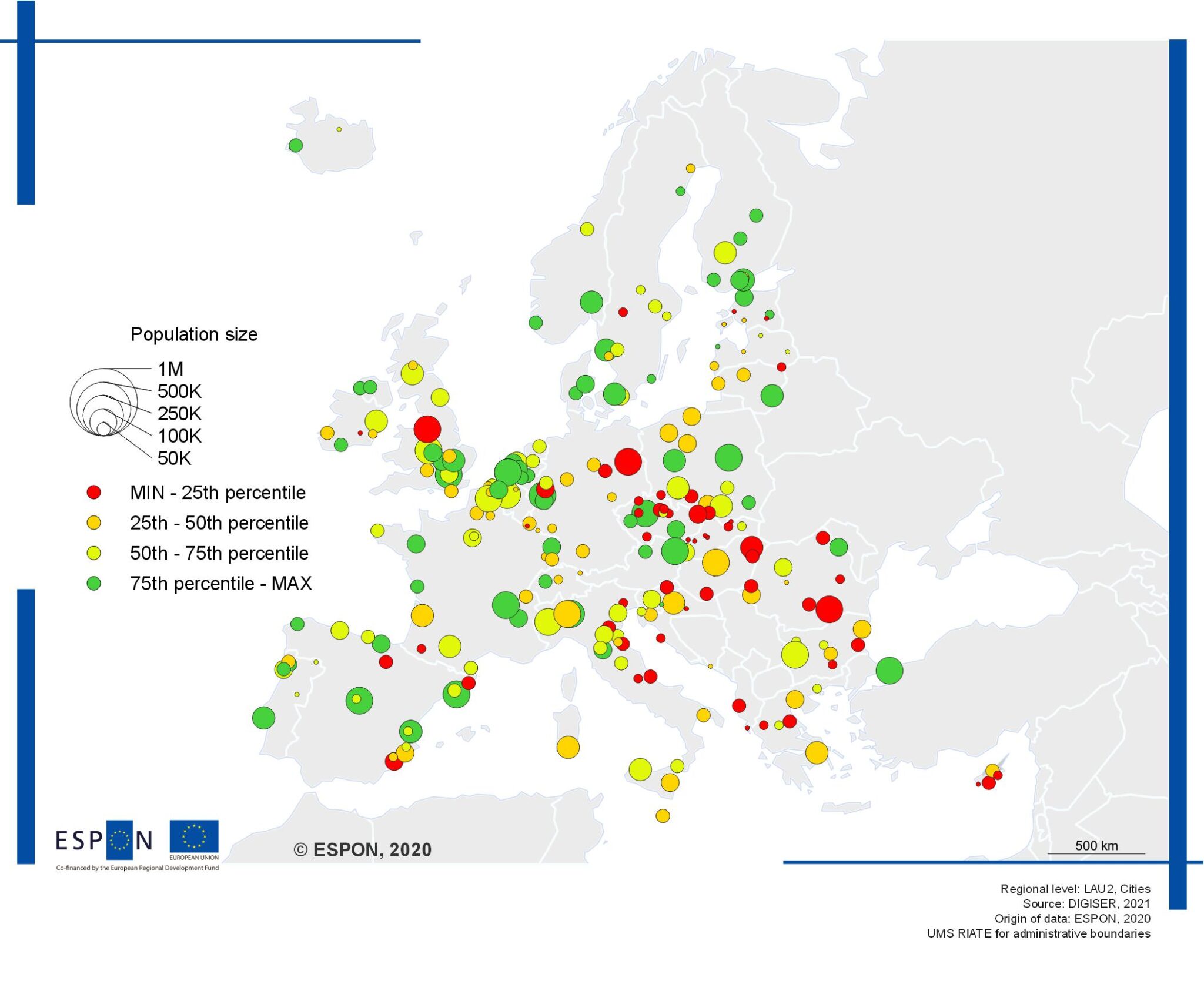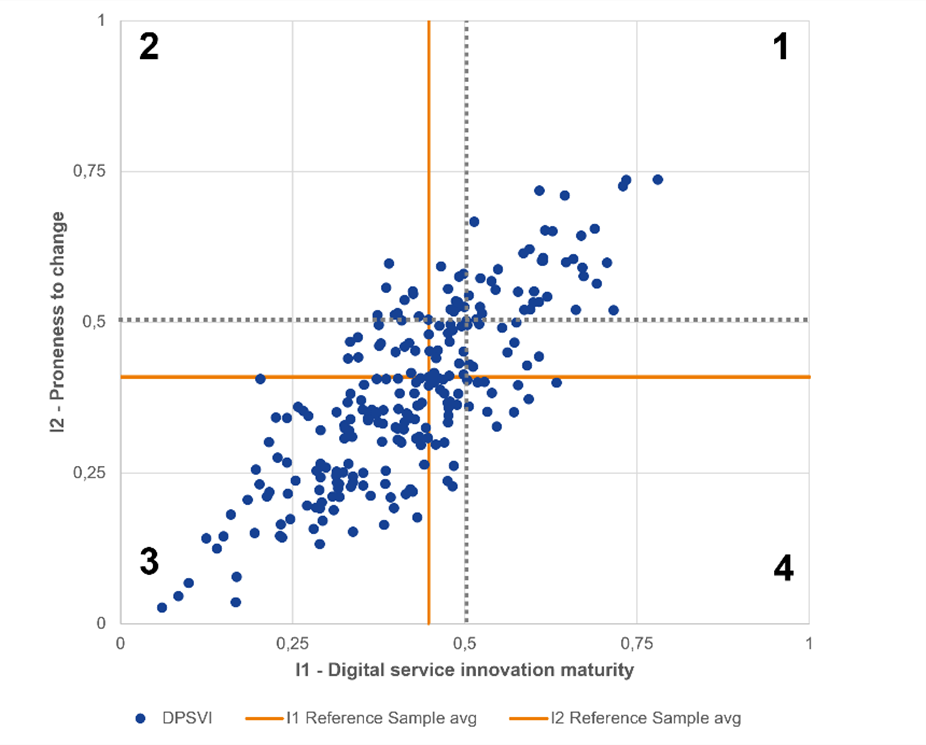DIGISER: new approach to measuring digital transformation of public services locally

By Michelangelo Secchi (Politecnico di Milano), Frank Holstein (Deloitte Tax & Consulting, Luxembourg) and Ana Robalo Correia (Deloitte Technology, Portugal)
This article presents the Digital Public Service Value Index (DPSVI), an indicator measuring digital transformation at a local level in Europe. As current indicators fail to capture the key aspects and drivers of public services’ digital transformation, the DPSVI was developed by the European Observation Network for Territorial Development and Cohesion’s (ESPON) DIGISER study (ESPON, 2022). By analysing feedback from 248 European cities and performing multiple case studies the study provides information on lessons learnt, success factors and bottlenecks faced by cities and public services undergoing digital innovation. The ESPON study was carried out by a consortium of partners, led by OASCities and including Politecnico di Milano, Deloitte and Catapult CPC.
Measuring digital transformation of public services in European cities
Digital transformation is the combined effect of digital innovations, such as a more customer-driven perspective, requiring far-reaching and cross-cutting organisational change alongside digital technologies (Cochoy, Hagberg, McIntyre, & Sörum, 2017). In other words, it describes the transition from a highly specialized public sector of well-established, stable and siloed structures made up of public officials in a hierarchical chain of command, to providing public services through non-linear, shared management and dynamic and flexible processes in connected environments (Holmström, 2018).
This transformation not only impacts governance, collaboration policies, experimental tendencies, skills and capacities, but also budgets and procurements, so indicators measuring progress should capture this interdisciplinary and multidisciplinary approach. However, most indicators depict the availability and use of technologies for digital transformation based on available statistical data from Eurostat or national open datasets. Therefore, they fail to capture causal linkages of technology-driven digital transformation.
In addition, comparable data on digital transformation at the local level is lacking in Europe, despite the fact that a large share of public services to citizens is provided at this level, i.e., in cities and metropolitan areas. In recent years, several European and international institutions have tried to measure public administrations’ governance and implementation of digital transformation at organisational and territorial levels. However, these indicators only depict digital transformation at a national level or, in a few cases, at a regional (NUTS-2) level.
DPSVI
ESPON’s DPSVI addresses these challenges by considering organizational transformations and relevant socio-economic variables through a multilevel composite index, fed by primary data collected through a questionnaire (DIGISURVEY) targeting European cities. The index captures and synthetically describes cities’ digital transition performance and their ability to create public value through this transition.
The DIGISER study standardised, aggregated, processed and combined data collected from 248 European cities to feed a system of composite indexes that assess these cities’ performances, taking into account the complex phenomena underlying digital transformation. Figure 1 provides an overview of the data collection and processing approach.
Figure 1 – DIGISER data management flow

Source: ESPON 2022
The index includes different measurements to describe the changing nature of local governments’ structures and service provision processes that enable and scale up digital innovation, including ways of working, the role of data, standards and platforms, multilevel governance, and networking.
The composite indexes are clustered into two broad topics: digital service innovation maturity and proneness to change. Digital service innovation maturity describes, for example, the level of digital maturity and service embedment. While proneness to change describes aspects of change management and innovation governance, including the level of data management, societal engagement and institutional capacity. The ESPON report describes all indicators used in detail.
Territorial patterns of public service digital transformation in European cities
When mapping cities through DPSVI, large centres of commerce and capital cities are shown as more advanced in the digital transformation of their public services, due to their access to funding and skilled staff. Geographically, the cities leading the adoption of digital innovation are in the Netherlands, Baltic countries, and Scandinavia, while follower cities are located in the Mediterranean and Eastern Europe. While public authorities’ performance in the Iberian Peninsula has stabilized, their central European peers are still lagging (Figure 2).
Figure 2– DPSVI Spatial Trends Cities’ ability to leverage digital transformation to create public value

Source: ESPON 2022
In addition, the DPSVI classifies European cities based on their level of maturity and proneness to change. Of the cities surveyed, 67% are classified as “conservative followers” showing low penetration and maturity of digital transformation in their public service delivery. Moreover, these public authorities are seemingly not inclined nor ready to modify their behaviour to support organisational or technological innovation. As a result, digitalising public service provision mainly relies on well-established and siloed governance structures that slowly adapt and evolve to the private sector’s more efficient practices.
The DPSVI also identifies transformative pioneers. These public authorities are generally aware and ready to actively support changes in organisational behaviours, attitudes, and procedures to tackle digitalization challenges and drive pervasive and transformative service innovation practices. As such, these cities provide valuable insights into possible drivers for digital transformation.
One example of a transformative pioneer is Helsinki, Finland, which wants to become the “most functional city in the world” by shifting the service delivery paradigm from reactive to proactive in order to anticipate the population’s needs and provide more targeted solutions. For this, the city has used and shared public data since 2008, leading to opportunities for businesses and services around mobility, energy management and the environment. In addition, the city’s innovation company (Forum Virium) helps develop and maintain the city’s innovation ecosystem by bringing together relevant players in its projects (ESPON, 2022 – Case study annex).
Drivers for digital transformation
The DPSVI provides valuable data and insights on drivers of digital transformation at the local level.
For example, it shows that scale is an important driver for digital transformation. Public authorities with bigger populations, while not necessarily the wealthiest per capita, tend to adopt digital innovations more than their smaller peers. One reason is that the complexity of service provision increases with population size; therefore, a larger public authority gains more from investing in digital technology to simplify these processes. In other words, large public authorities benefit from economies of scale.
Organisational change is another important driver for digital transformation. This refers to public authorities’ attitudes towards using data, engaging with society and improving institutional capacity, as described by the proneness to change index. The index highlights a correlation between the level of digital transformation in a public authority and its capacity and attitude toward organizational innovation.
Figure 3 shows the correlation between the DPSVI’s two main sub-indicators, digital maturity and proneness to change, which are proportionally distributed. While this correlation is not particularly surprising, this finding supports the theory that digital transformation does not happen in a vacuum but requires organizational changes.
For example, Porto in Portugal is a transformative pioneer that has created a horizontal institution (Porto Digital) to embed a collaboration with the innovation ecosystem as part of its public service provision’s DNA, therefore contributing to novel approaches in the municipality and counteracting internal resistance to change (ESPON, 2022 – Case study annex).
Figure 3 – Digital transformation is aligned with organizational innovation

Source: ESPON 2022
Next steps
The ESPON DIGISER study’s DPSVI index is a first step to mapping digital transformation across European cities, depicting digital transformation at the local level and exploring the drivers for digital transformation. All DIGISER data is available on the ESPON database for download under an open license. As its methodology and information can be used with other data sources to explore further correlations and data-driven explanations, the study contributes to a further understanding of digital transformation. This enhanced knowledge could improve the uptake of digital innovations and advance digital transformation across Europe.
References
Cochoy, F., Hagberg, J., McIntyre, M. P., & Sörum, N. (2017). Digitalizing consumption: introduction. In: F. Cochoy, J. Hagberg, N. Sörum, & M. P. McIntyre, Digitalizing consumption: how devices shape consumer culture (pp. 1-19). London, UK: Routledge
ESPON (2022) DIGISER Digital Innovation in Governance and Public Service Provision. Main Report. Luxembourg: ESPON EGTC
ESPON (2022) Annex 1.6 case studies on Digital Innovation in Governance and Public Service Provision. Luxembourg: ESPON EGTC
Holmström, J. (2018). Recombination in digital innovation: Challenges, opportunities, and the importance of a theoretical framework